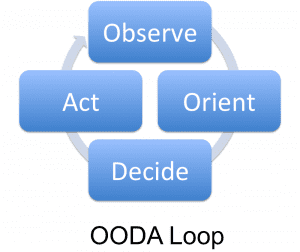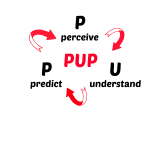Observe-Orient-Decide-Act (OODA)
 The OODA loop stands for Observe -> Orient -> Decide -> Act. And as the term loop indicates, the process is continual. The OODA model was developed by John Boyd, a military strategist and applied to fighter jet operations. Boyd developed the OODA loop model while serving as a fighter pilot in the Korean war and used it to explain the process for achieving success in air-to-air combat.
The OODA loop stands for Observe -> Orient -> Decide -> Act. And as the term loop indicates, the process is continual. The OODA model was developed by John Boyd, a military strategist and applied to fighter jet operations. Boyd developed the OODA loop model while serving as a fighter pilot in the Korean war and used it to explain the process for achieving success in air-to-air combat.
The OODA loops begins with making observations about what is happening in the environment, outside information, unfolding circumstances and implicit guidance and control (which I assume refers to aircraft guidance and control but I could not locate an explicit definition.
The orientation component of the OODA loop involves understanding, cross-referencing and combining genetic heritage, cultural traditions, analysis and synthesis, previous experiences and new information.
The third component involves making the decision hypothesis and, finally, to implement an action. The action then unfolds and interacts with the environment and the process starts all over again. Hence, the term loop.
Situational Awareness and Decision Making
 The model for forming situational awareness that I prescribe to is: Perceive-Understand-Predict (PUP). Like OODA, this process is also a loop, and thus, is continual.
The model for forming situational awareness that I prescribe to is: Perceive-Understand-Predict (PUP). Like OODA, this process is also a loop, and thus, is continual.
Responders should use situational awareness as the foundation for good decision making. PUP is not, unto itself, a decision making model. The PUP process supplements the decision making model.
Dynamic decision making Process (DDM)
The model I advocate for making decisions in dynamic environments is very similar to the OODA loop, but it adds the component of anticipating outcomes prior to implementing the action. The process looks like this:
1. Conducting a size-up
2. Focus your attention on no more than 5-7 critical clues and cues.
3. Compare the current situation to past experiences.
4. Assess and evaluate novel (never before seen) information.
5. Make a decision.
6. Anticipate the outcome of the decision.
7. Implement the action.
If the anticipated outcome of the decision (Step 6) is not good, then do not proceed to step 7. Instead, go back and repeat steps 5 and 6 until you can come up with a plan that is viable.
The main difference between the OODA loop and the DDM model comes at step 6 – anticipating the outcome of the decision before implementing the action plan.
 The premise of the OODA loop is to first observe your surroundings. This is the equivalent of the perception phase of the situational awareness development process. Here, the terms observation and perception are synonymous. Both terms mean you are paying attention to your surroundings and gathering information about what is happening in your environment.
The premise of the OODA loop is to first observe your surroundings. This is the equivalent of the perception phase of the situational awareness development process. Here, the terms observation and perception are synonymous. Both terms mean you are paying attention to your surroundings and gathering information about what is happening in your environment.
The second component of the OODA loop is to orient. This is the equivalent of understanding phase of the situational awareness process. Here, the terms orientation and understanding are synonymous. Both terms mean you are taking the information gathered and trying to make sense out of what is happening.
The next phase is where the OODA loop and the DDM model diverge slightly. If using the OODA loop, after orienting you would make a decision and implement an action. If using the DDM model, the decision would be followed by a pause to anticipate (i.e., predict or forecast) the outcome of the decision BEFORE the action.
Rich Gasaway’s Advice
 If you wanted to merge the concept of prediction into the OODA loop, it would become OODPA – Observe-Orient-Decide-Predict-Act. Granted, this does make for one messy acronym. I’ll get to work on developing friendlier terms. In the meantime, simply remember to predict outcomes prior to implementation.
If you wanted to merge the concept of prediction into the OODA loop, it would become OODPA – Observe-Orient-Decide-Predict-Act. Granted, this does make for one messy acronym. I’ll get to work on developing friendlier terms. In the meantime, simply remember to predict outcomes prior to implementation.
Predicting future outcomes is one of the toughest things to remember while operating in high stress environments under time compression. Once the initial size up is complete and you decide on your action plan, it is very easy to move right into the implementation of your plan without giving thought to outcome of the plan first. When you force yourself to think about the outcome, it causes you to think through the steps to achieve the plan and you may be able to see where your plan might go awry before you start down that path.
As additional responders arrive on the scene, they should also be following the same process of Observe-Orient-Decide-Predict and Act (OODPA). But what they are observing and orienting too will be slightly different because they will be building on decisions and actions already implemented by the previous crew(s).
The subsequent arriving crews should assess the progress being made by their predecessors. If the plan is working, then make decisions about how to support the existing plan. If that plan is not working, then assess why and make a determination if something can be done to supplement or augment the already implemented plan. Alternatively, if the plan is not working make a decision to order the already engaged personnel to a new course of action.
Action items
 1. Discuss the process you use for making decisions at emergency scenes.
1. Discuss the process you use for making decisions at emergency scenes.
2. Discuss the benefits and challenges of the OODA loop and the DDM model.
3. Discuss the importance of size up and how it integrates into the OODA loop or the DDM model).
4. Discuss the benefits and challenges of anticipating future outcomes prior to implementing your action plan.
_____________________________________________________

If you are interested in taking your understanding of situational awareness and high-risk decision making to a higher level, check out the Situational Awareness Matters Online Academy.
CLICK HERE for details, enrollment options and pricing.
__________________________________
Share your comments on this article in the “Leave a Reply” box below. If you want to send me incident pictures, videos or have an idea you’d like me to research and write about, contact me. I really enjoy getting feedback and supportive messages from fellow first responders. It gives me the energy to work harder for you.
Thanks,

Email: Support@RichGasaway.com
Phone: 612-548-4424
SAMatters Online Academy
Facebook Fan Page: www.facebook.com/SAMatters
Twitter: @SAMatters
LinkedIn: Rich Gasaway
YouTube: SAMattersTV
iTunes: SAMatters Radio

Pingback: SURVIVALISTS BLOG | Enhancing the OODA Loop – Situational Awareness Matters!™
SIPDE:
Scan (the environment)
Identify (conflicting interests)
Predict (what the other party will do)
Decide (what you will do if your prediction comes true)
Execute (do it)
Or some version thereof
I would think of it as
1) observe
2) orient
3) predict
4) decide
5) act
OODAA
…Anticipate
…Act
Pingback: Situational Awareness and Self-Awareness | Dave Parker